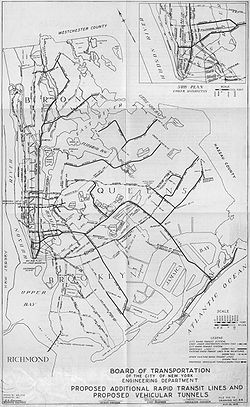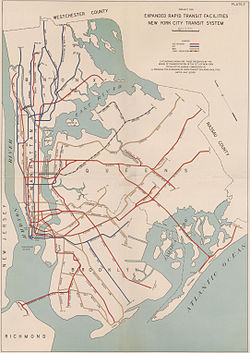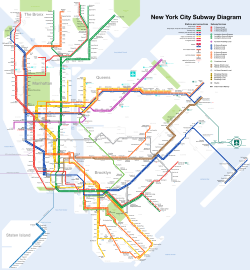Since the opening of the original New York City Subway line in 1904, and throughout the subway's history, various official and planning agencies have proposed numerous extensions to the subway system. The first major expansion of the subway system was the Dual Contracts, a set of agreements between the City of New York and the IRT and the BRT. The system was expanded into the outer reaches of the Bronx, Brooklyn, and Queens, and it provided for the construction of important lines in Manhattan. This one expansion of the system provided for a majority of today's system.
Even with this expansion, there was a pressing need for growth. In 1922, Mayor John Hylan put out his plan for over 100 miles of new subway lines going to all five boroughs. His plan was intended to directly compete with the two private subway operators, the IRT and the BMT. This plan was never furthered. The next big plan, and arguably the most ambitious in the subway system's history, was the "Second System". The 1929 plan by the Independent Subway to construct new subway lines, the Second System would take over existing subway lines and railroad rights-of-way. This plan would have expanded service throughout the city with 100 miles of subway lines. A major component of the plan was the construction of the Second Avenue Subway. The Stock Market Crash of 1929 put a halt to the plan, however, and subway expansion was limited to lines already under construction by the IND.
During the 1930s and 1940s, the plans were revised, with new plans such as a line to Staten Island and a revised line to the Rockaways. In the late 1940s and 1950s, a Queens Bypass line via the Long Island Rail Road's Main Line was first proposed as a branch of the still-planned Second Avenue Subway. In addition, capacity on existing lines became improved through the construction of strategic connections such as the Culver Ramp, the 60th Street Tunnel Connection, and the Chrystie Street Connection, and through the rebuilding of DeKalb Avenue Junction. These improvements were the only things to come out of these plans. Eventually, these plans were modified to what became the Program for Action, which was put forth by the New York City Transit Authority in 1968. This was the last plan for a major expansion of the subway system. The plan included the construction of the Second Avenue Subway, a Queens Bypass line, a line replacing the Third Avenue El in the Bronx, and other extensions in the Bronx, Queens, and Brooklyn. While ambitious, very little of the plan was completed, mostly because of the financial crisis in the 1970s.
Until the 1990s, there was little focus on expansion of the system because the system was in a state of disrepair, and funds were allocated to maintaining the existing system. In the 1990s, however, with the system in better shape, the construction of the Second Avenue Subway was looked into again. Construction of the Second Avenue Subway started in 2007, and the first phase was completed in 2017. Since the 1990s, public officials and organizations such as the Regional Plan Association have pushed for the further expansion of the system. Projects such as the TriboroRx, a circumferential line connecting the outer boroughs, the reuse of the Rockaway Beach Branch, and the further expansion of the Second Avenue Subway have all been proposed, albeit mostly unfunded.




